In this article we’ll explain how noise can have a serious effect on your driving ability and your health, and what steps you can take to choose a quiet car.
Temporary loud noise is distracting. Especially when you are learning to drive, having noisy mates in the car can distract you enough to take your attention away from the road. But what about the constant background noise that your vehicle makes, and how does this affect your concentration and health if you are in the car for long periods of time?
What creates cabin noise in a vehicle?
There are eight main factors:
Occupants
Whether it’s a child, your aunty or your pet dog, your vehicle occupants will make noise at some time. This isn’t constant noise, but it can be distracting. It also isn’t something you can do much about, however, you should consider what their needs might be if you travel a lot with passengers, particularly children. Later on we’ll look at what type of cars are best for this.
Engine noise
In order to propel your car forwards, fuel is exploding within the engine, and that is noisy in itself. The exhaust system channels the noise to the back of the car and uses a silencer (muffler) to dampen the noise before it exits the back. If there’s a hole in your muffler then you will notice a greater amount of sound.
If your exhaust is a performance exhaust it will offer less resistance to the sound in the silencer and will therefore be louder.
Your driving style
If you tend to drive the car hard up through the rev range you will experience a noisier journey. Vehicles at the peak of their rev range can be very noisy – in fact, a Ferrari Enzo is well over 100dB at peak revs in first gear, which is eight times louder than an average car travelling along a road at 100kph in top gear at 70dB. We’ll explain this more in a minute.
Conductive vibration
Your car is made of thousands of parts all screwed and glued together. Sometimes these parts will become a little loose and that allows them to vibrate. There’s also conducted noise through the chassis that will resonate and vibrate other parts in your car whether they are loose or not. All these contribute to noise in the cabin.
Wind noise
As wind hits the car turbulence is created around the wing mirrors, panel gaps, door seals, and any trim or bits that stick out. Vehicle manufacturers are constantly trying to create ever more streamlined vehicles, and this is measured using the coefficient of drag. The less drag, generally the less turbulence and wind resistance and (usually) this results in less wind noise.
Wind noise will be much more if you open the windows.
Air conditioning
Air conditioning fans create noise in themselves, plus the noise of the air exiting the vents at high speed can be considerable if the air con is on full.
Road noise
Road noise is arguably the most significant contributor to the noise of a vehicle, and it’s also the one that you can often do the most to reduce. The primary reason is the tyres crossing a rough surface. The tyres have to deform slightly as the roll, and the rough surface imparts noise and vibration into the suspension components and chassis.
A wet, coarse surface will be much louder than a smooth, dry surface. But the type of tyre also plays a large part. The wider the tyre, the more noise it will create. The tread pattern will affect the noise, as well as the softness of the rubber (softer is less noisy and absorbs shocks better), and the aspect ratio (the ratio between the width of the tyre and the height of the sidewall – higher aspect ratio is better).
Buying a quiet car: what you should look out for
Manufacturer’s figures
Many manufacturers publish their cabin noise figures, but not all. Search online to see if you can find any. But bear in mind that the figures will be recorded in ideal situations, and that won’t always reflect the types of road surfaces we have in NSW.
Manufacturers constantly try to reduce what’s called NVH, or noise, vibration and harshness. They may give a figure in decibels (dB) for cabin noise at a certain speed. We’ll explain decibels below.
Engine type
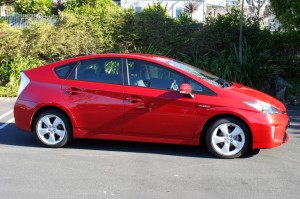
A second hand Toyota Prius, such as this 2012 i-Tech, will offer quiet around-town motoring on its electric motor
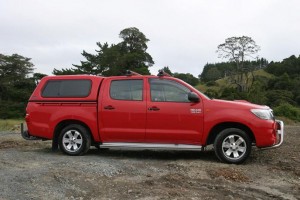
Whereas this 2011 Toyota Hilux has plenty of road and engine noise
A fully electric car will be the quietest in terms of engine noise as there are no explosions of fuel.
The next best option is a modern hybrid (older hybrids are likelier to have noisier petrol engines than a newer petrol-only vehicle). A recently Toyota Prius could be had for reasonable money
A newer large-capacity diesel is usually the next quietest, followed by lower capacity petrol and diesel, and finally sports cars.
Large capacity diesel utes tend not to be quiet. For example, a Nissan Navara, Mazda BT-50 or Toyota Hilux is not going to be like a BMW 520d.
An engine’s characteristics under acceleration will affect noise. There are distinct differences in the sound between eight-cylinder, six-cylinder, five-cycliner, boxer-4-cyclinder, inline-4-cyclinder, VTEC and rotary engines. Cars with 3-cylinders can also be quite noisy because they tend to be at the very cheap end of the price range where less sound deadening is used.
Sound proofing
Sound proofing is generally better on more expensive cars and worse on smaller, cheaper cars. Carpets are the most obvious means of sound proofing, but it also extends to door seals and any materials under the carpets. Deadening material such as Dynamat can be purchased for self-installation, or you can have it done by a professional.
Tyres
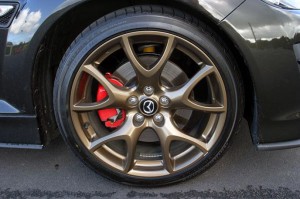
RX-8’s wheels look flash, but you can feel the bumps
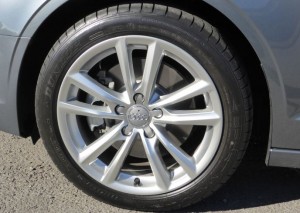
Audi A3’s wheels a slightly softer with the higher sidewalls
The type of tyres and their condition (inflation, tread depth, etc) are arguably the biggest factor that is under your control. It’s fairly easy to change your tyres and you can search online for people’s experiences with different tyres. If a vehicle has had different tyres put on it from that which the manufacturer installed, it could have had a positive or negative effect on the noise. The tyres a manufacturer chooses will be based on a number of factors such as cost, look, performance, feel and noise.
If you have a tyre with a small hub and high sidewall (high aspect ratio), these tend to be quieter. The aspect ratio is the ratio between the width of the tyre and the height of the sidewall, i.e. height divided by width times 100.
As an example, a 205/60R16 tyre has an aspect of 60. A 225/45R17 tyre from an Audi A3 will, all things being equal, be quieter than the 225/40R19 tyres on this Mazda RX-8 Spirit R.
However, what’s not certain is that the A3’s tyres are 91Y, which means they are rated to 300kph, and therefore will be stiffer than the 89W tyres (rated to 270kph) of the RX-8. The stiffness of construction plays a part in the generation of noise. Y means it’s rated to 300kph and W means it’s rated to 270kph. The 89 means the RX-8 is rated to 580kg per tyre and the 91 means that the A3 is rated to 615kg per tyre.
Subframe construction
If the car has a subframe vibrations can be isolated from the main body using rubber bushings. Many cars are made with a unitary construction, but that allows vibration to travel directly from the suspension components through the chassis in to the cabin.
Type of car
While a lot of factors affect this, the general type of car will determine whether it might be quiet. A sports car will have less of an emphasis on sound deadening and more of an emphasis on stripping away weight (sound deadening is heavy), and providing a ‘sporty’ experience, which will include the level and quality of engine and exhaust noise in the car.
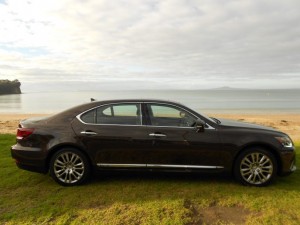
The LS600hl Lexus is probably the quietest car I’ve driven. But it’s also the best part of 300 hundred grand!
A luxury car, on the other hand, is designed to be more comfortable and softer to drive in. More emphasis will be put on making the environment as pleasant as possible. It’s likely to be heavier with more sound deadening, and therefore quieter.
Cheaper cars will have compromises. Their budget constraints will mean less emphasis is put on out-and-out noise reduction, with more of a balanced compromise being sought between performance, comfort and price.
Extremely cheap cars are almost universally harsh sounding as they have smaller engines that need to be worked harder to get the performance from them, and are consequently noisier.
Large SUVs offer more wind resistance and therefore can be noisier. They often ride on wider tyres, too.
Utes and work vehicles tend not to have emphasis put on sound deadening because price points are important when purchasing for a business.
A station wagon will be noisier than a sedan because the noise from the rear of the car can enter the cabin more easily rather than being trapped in the boot.
How is sound measured?
Sound is measure in decibels (dB). The minimum change in volume that most humans can perceive is 3dB and this equates roughly to doubling the sound energy. But doubling the sound energy doesn’t mean doubling the volume. 10dB is the increase at which you’ll perceive that the volume has doubled, and because it’s logarithmic, if it goes up another 10dB it doubles again. Therefore 50dB is four times as loud as 30dB (30 to 40dB doubles, and 40-50dB doubles again).
Some examples of dB ratings
20dB – rustling leaves
30dB – whispering
50dB – light traffic
60-70db – normal conversation range
80dB – alarm clock
100db – riding a motorbike
110db – moderate rock concert
130db – peak stadium crowd cheering
An average car cruising a road with a smooth surface will typically produce around 70dB in the cabin, but not all cars are made equal. A Porsche GT3 creates just under 80dB while a BMW 730d creates just under 60dB. That’s a 20dB difference, which, as we explained above, means four times the volume in the Porsche. Part of the attraction of driving a GT3 will be the noise, but over a long distance that sound is not only tiring, but also can be damaging.
Various agencies produce charts to show how much continuous average noise exposure you can have before hearing damage starts to occur, and the following are the acceptable standards. For every 3dB increase, the amount of sound you can be exposed to before damage halves.
- 79dB – 32 hours
- 82dB – 16 hours
- 85dB – 8 hours
- 88dB – 4 hours
- 91dB – 2 hours
- 94dB – 1 hour
- 97dB – 30 minutes
- 100dB – 15 minutes
- 103dB – 7.5 minutes
- 106dB – < 4 minutes
- 109dB – < 2 minutes
- 112dB – < 1 minute
- 115dB – <30 seconds
You might be looking at this charge thinking that it doesn’t apply to you. You don’t have a Porsche GT3 and you probably have something like a Honda Civic which you think is quiet. Add a radio station on top of the Civic’s noise and you can easily bump this up to 90dB. Then take a long journey and you might find that when you stop your ears feel different. This is because the muscles in the ears have contracted to start to protect your ear drums. Do this enough and you’ll start getting tinnitus – a ringing in your ears.
High levels of noise over a long period of time fatigue your brain and cause you to lose concentration.
How should you choose your car, though?
It’s all well and good discussing the academics of sound production and measurement but, short of buying a noise meter, which you can do from Amazon by clicking here, your only way is to drive several cars and subjectively evaluate which one you like the best.
It also comes down to your needs. If you have children and you’re carrying them for long journeys frequently, then consider the noise in the back of the car. A station wagon might be practical, but it will also be noisier than a sedan.
Big alloys might look good, but smaller alloys and fatter tyres will not only ride more smoothly, but should be quieter, too.
If you are a road warrior and use your car for business, picking a quiet car will be less tiring. If you’re using a hands-free phone kit to make calls, the volume won’t need to be as loud.
Of course, purchasing a car solely on the noise characteristics is ridiculous. You should also be considering safety, fuel economy, suitability for your budget and needs, and whether you like the look and feel of the car. Noise is something you should throw into the mix – something that shouldn’t be ignore or forgotten, but shouldn’t scream too loudly in the whole purchasing decision.
